Arizona comet hunter Don Machholz did it again! He discovered his 12th comet only two mornings ago. Set your alarm, grab your scope, and take a look.
UPDATE (Nov. 11, 2018): Comet brightens and gets an official name. Scroll down for news and new maps.
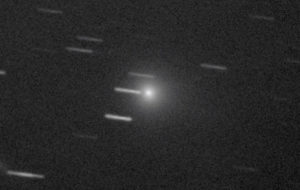
Jean-Francois Soulier
With all the automated searches busily looking for anything crawling across the sky, it's a wonder an amateur can still discover a comet. Yet that's exactly what happened on November 7.53 UT, when Don Machholz, the most successful living visual comet hunter, visually picked up a new comet in Virgo near the break of dawn from his Colfax, California home. Two Japanese observers — Shigehisa Fujikawa and Masayuki Iwamoto — independently spotted the object around the same time and potentially will have their autographs added to the comet's final, official name.
Let's hear it from the discoverer via his Twitter account:
"746 hours of searching since my last visual comet discovery in 2010 and on Nov. 7.53 UT I visually discovered my 12th comet and today it was confirmed!"
Congratulations, Don — you beat the robots!

Michael Jäger
For now, the comet has been given the temporary designations TCP J12192806-0211143 and DM001. According to early observations shared on the comets-ml mailing list, the new object is magnitude 10.2 with a moderately condensed 4′ (arcminute) coma and a short tail extending west in position angle 264°. Lucky for us, the new visitor stands about 20° high just before the start of morning twilight in Virgo, quite close to the easy naked-eye star (and beautiful double!) Gamma (γ) Virginis .
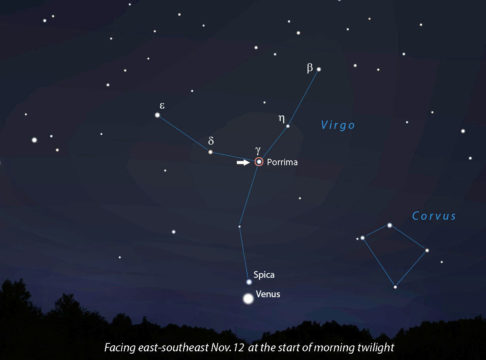
Stellarium
We don't have many more details on the comet because an accurate orbit is still being determined. I used current ephemerides to plot its position for the next couple mornings so as many people as possible can tote out a scope for a look. With the comet at 10th magnitude under reasonably dark skies, an 8-inch should show it no problem. We'll have an orbit In the next few days, after which time I'll post a chart for more extended viewing.
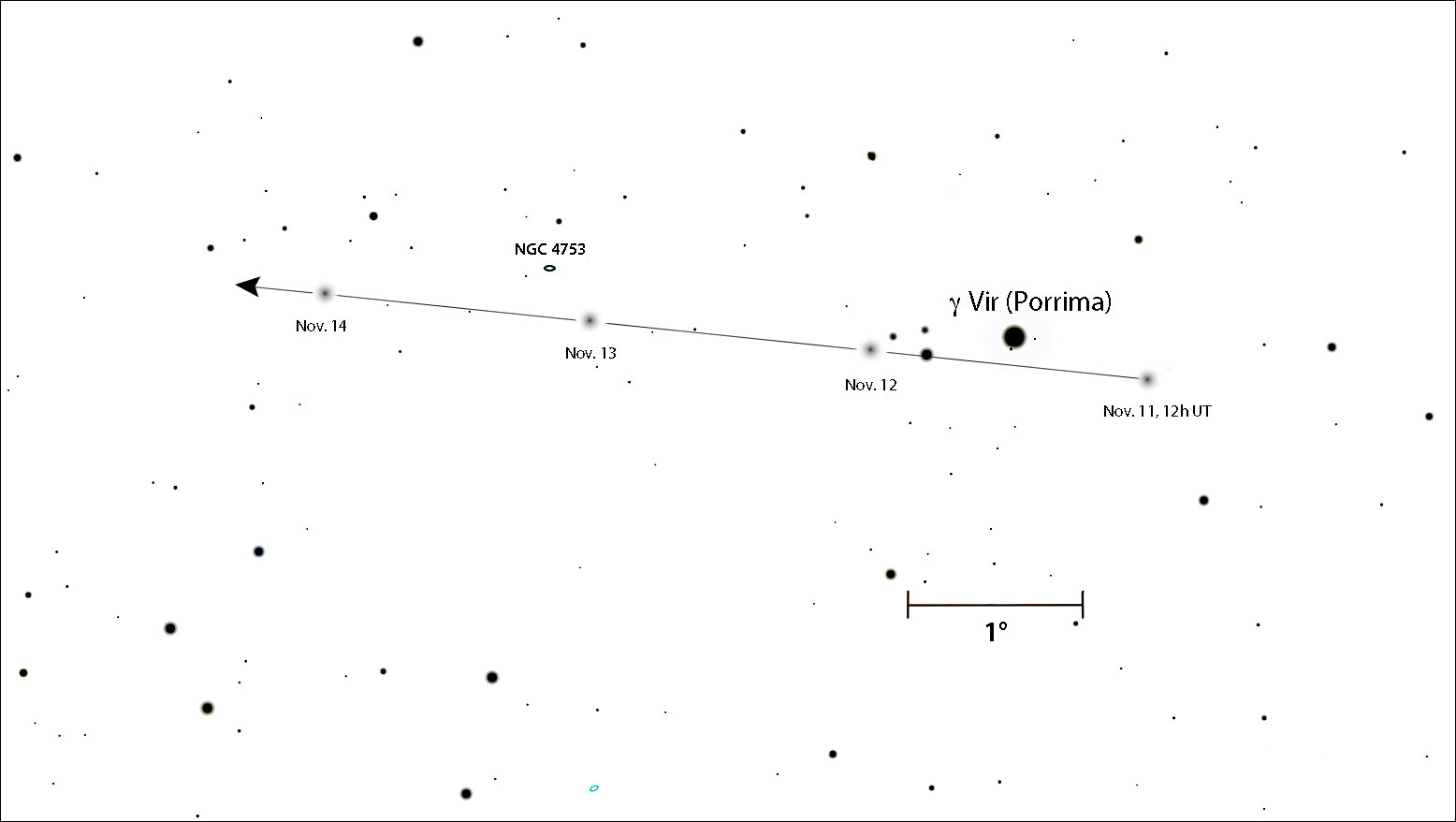
Stellarium
In the meantime, you can use these orbital elements, kindly provided by Reinder Bouma, in your sky mapping apps and programs to create your own charts:
T = 2018-12-03.57797, q=0.3850987, e=1.0, peri=89.16004, node=128.86148, i=143.72993
It's unclear just when perihelion will be — I've seen estimates from late November to mid-December. We'll know soon as to whether this is a brand new object or the return of a long-lost periodic comet. Likely the former.
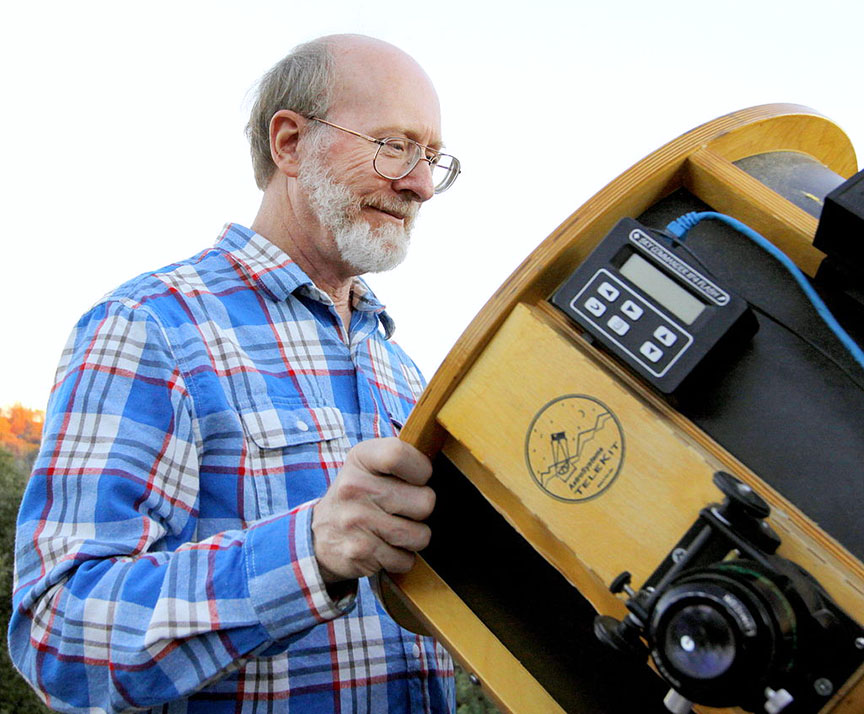
AnneLouis Machholz
For more details, go to the Central Bureau for Astronomical Telegrams Transient Object Followup Reports and the Minor Planet Center's Possible Comet Confirmation Page, where you can select "DM001" and click ephemerides to get updated positions.
It's so exciting to have a new comet discovery, especially a visual one made by an amateur astronomer. I'm as eager as you to train my telescope on this new visitor. Clear skies!
** Update: (November 10th) I looked for the comet this morning (November 10.48 UT) and was surprised how easy it was see in my 10-inch f/4.5 Dob. I star-hopped to the position at 56× and bingo, there it was! I estimated magnitude 9.5 with a well-condensed (DC=5) coma 3.5′ wide and a hint of a westward tail. A Swan Band filter modestly enhanced the comet's visibility. Using higher magnification I discerned a faint, a ~13-magnitude stellar nucleus. More observations of the comet reveal the perihelion date is likely December 3rd, when it will approach within about 56 million kilometers of the Sun.
** Update: (November 11th) The comet appears to be brightening, with some observers spotting it in 56-mm binoculars. Estimates range from magnitude 8.5 to as bright as 7.5. This is an easy object! And while you're out, don't forget to look low near the horizon just as twilight starts for a close pairing of Venus and Spica.
** Update: (November 11th) Our comet just got an orbit and official name: C/2018 V1 (Machholz-Fujikawa-Iwamoto). See map and caption below for more details.
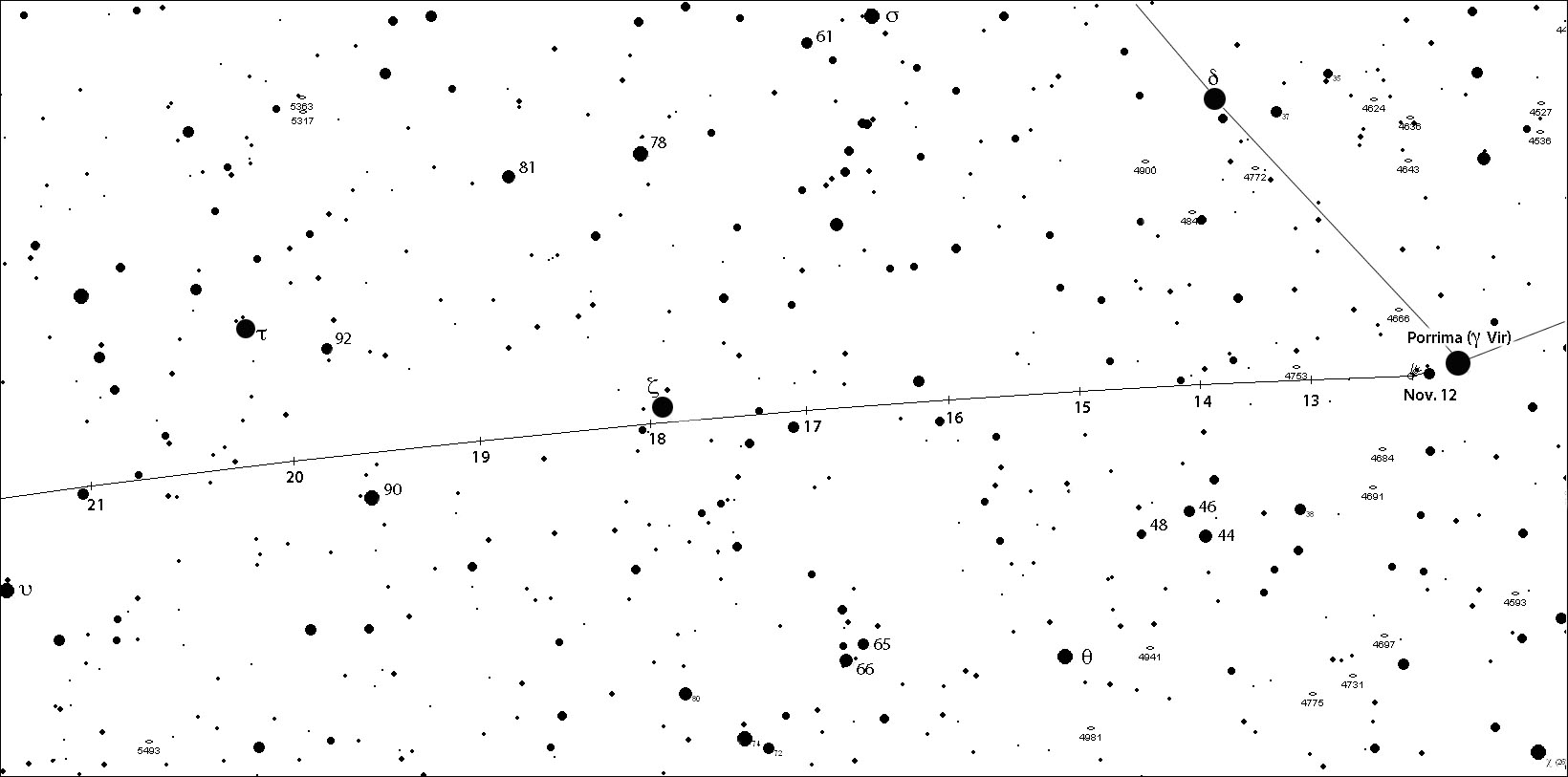
Chris Marriot's SkyMap
 24
24








Comments
Tom-Reiland
November 10, 2018 at 1:20 am
I am so happy to hear about Don's visible discovery of this comet. I'm glad that he kept trying and that it paid off for him. I am not a fan of the automated search groups out there. I cannot get excited about sitting in front of a computer, controlling a telescope, possibly from the warmth of one's home, to search for Novae, SNs, and Comets. I guess I'm old-fashion and still enjoy the romance of scanning the night sky for anything new that the Universe might send our way. For a while there, I thought my discovery of the SN in M51 in 2011 might have been one of the last visible discoveries. Here's hoping Don's won't be the last one.
You must be logged in to post a comment.
Bob KingPost Author
November 10, 2018 at 10:08 am
Hi Tom,
It's great news, isn't it? I got up this morning to see the new comet — very easy, bright and condensed in my 10-inch. You're going to enjoy this one. I hope you have a clear morning soon. For more details on the comet I updated the story — go to the end.
You must be logged in to post a comment.
Tom-Reiland
November 11, 2018 at 8:36 am
Bob, thanks for your excellent chart and description of Comet Machholz. We had a public star party in the evening and I headed home after the last group left to take a nap before I returned to Wagman Observatory this morning. I had no trouble locating the comet and was pleasantly surprised at its brightness. It was just as you said, bright and condensed in the 21" at 127X and also in the 5" f/5 Jaegar's (not sure of my spelling) at 25X. I couldn't locate it through my 10 X 50s because of the minor LP in that area of the sky. I estimated it to be brighter than 9 mag, probably at least 8.5 magnitude. I compared it to M51, which is listed at 8.4 mag in the Observers' Handbook. I checked out the comet from 4:53 until 5:06 AM and again at 5:41 when I noticed two faint stars pointing at it that I could not see or notice earlier. Of course less atmosphere to deal with it as much as 7 or 8 degrees higher. Thanks again, Bob.
You must be logged in to post a comment.
Bob KingPost Author
November 11, 2018 at 9:37 am
So glad you saw it, Tom and thank you for your observation and mag. estimate. I just updated the chart through Nov. 14.
You must be logged in to post a comment.
Tom-Reiland
November 12, 2018 at 5:53 am
Bob, your updated chart helped me locate the comet this morning from my light polluted backyard with my own Jaegar's 5" f/5 Refractor using 18 and 14 mm eyepieces for 35X and 45X. Because of my conditions, it was hard to judge the brightness, but I'm guessing it's 8.5 mag or brighter, but the inner coma was condensed and it was just off of the two dim stars closest to it. This was between 5:20 and 5:35 AM EST. Clouds started to move in and I got a glimpse of M3 before I picked up my scope and carried into the garage. It's nice having a very portable scope for quick observing.
You must be logged in to post a comment.
Bob KingPost Author
November 12, 2018 at 9:28 am
Good to hear it, Tom. I'm big into portable. I have 10-inch f/4.5 on a simple Dob mount. That's the one I used to spot the comet. I put the mount on my front seat and the tube in the trunk. At an observing site I can set up in 2 minutes and take down in the same. Great when it's really cold out but you simply MUST see a comet, nova, etc.!
You must be logged in to post a comment.
condensermike
November 10, 2018 at 2:15 pm
Great job! Astronomical discoveries has historically been in the hands of amateurs. Glad to see the community is still making significant contributions
You must be logged in to post a comment.
Anthony Barreiro
November 10, 2018 at 5:21 pm
Decimal UTC dates are less confusing than Julian dates, but only slightly.
The comet was discovered at 1243 hrs UTC, or 5:43 a.m. MST in Arizona.
You must be logged in to post a comment.
Joe Stieber
November 11, 2018 at 6:27 am
Finally, it was clear on Sunday morning, 11-Nov-2018, so I went out to the New Jersey Pines for my first attempt at seeing “Comet Machholz.” I arrived at 4:30 am EST (about 35 minutes before the start of astronomical twilight), got out my 15x56 binoculars, aimed at Porrima, shifted up and to the right a little based on Bob’s chart and there it was, a little fuzzy spot. I then got out my 85 mm spotting scope (27 to 60x) and confirmed it by 4:40 am. I never did set up my 12.5-inch Dob, it wasn’t necessary to see this comet (although I used it the previous evening to see comets 46P/Wirtanen and 64P/Swift-Geherls).
You must be logged in to post a comment.
Bob KingPost Author
November 11, 2018 at 8:44 am
Congrats Joe and thanks for sharing your observation. In binoculars no less! I hope it encourages other to go out for a look. I will be updating the finder map today.
You must be logged in to post a comment.
Tom Hoffelder
November 11, 2018 at 12:32 pm
And the official name. I went to the Confirmation Page and DM001, wasn't there, because as you know the comet is now C/2018 V1 (Machholz-Fujikawa-Iwamoto) - like in the good ol' days! It is suppose to be clear tomorrow morning, and cold (20 deg F), and a new comet is the only reason I'd be up and out, especially since our (Tom Reiland and I) Messier Marathon friend's name is part of the comet.
You must be logged in to post a comment.
Bob KingPost Author
November 11, 2018 at 1:12 pm
Like you Tom I'm very excited about this amateur discovery. Fires up the juices! Plus, C/2018 V1 appears to be getting brighter. I'll be out tomorrow a.m. as well. Clear skies!
You must be logged in to post a comment.
Tom Hoffelder
November 12, 2018 at 2:03 pm
It was clear and it is my comet #143! (Didn't know I hadn't seen a comet since 10/12/17 until I went to the spreadsheet to add 2018 V1.) Being less than one degree from gamma Vir, too easy to find with our 8" f/6 Newt this morning. I only have one are of light pollution, which is of course where the comet was, but my guess is 8th mag and 5' dia. Interesting but irrelevant, both the altitude of the comet and the air temp was 19.5 deg here in Norway Maine at 5 AM EST.
You must be logged in to post a comment.
Joe Stieber
November 12, 2018 at 7:16 am
I was out for another look on Monday morning, 12-Nov-2018. This time, I went to a suburban location that’s a little darker than my home, but not nearly as dark as the NJ Pines. On top of that, the transparency wasn’t ideal. I got going late, so it was past the beginning of astronomical twilight (5:08 am EST) by time I had my first look with 15x56 binoculars. Negative. Then I set up my 85 mm spotting scope on a tripod. I knew that C/2018 V1 (M-F-I) was near a compact triangle of stars half-a-degree east of Porrima, but not exactly where. At 5:28 am, using 60x, I detected a fuzzy patch off the eastern vertex of the triangle and made a diagram of it’s position. When I got home and checked against a SkyTools chart, my marked position matched the comet’s location at the time. My last view of the fuzzy patch was at 5:38 am as brightening twilight was washing it out.
You must be logged in to post a comment.
Bob KingPost Author
November 12, 2018 at 9:30 am
Thanks for your observation, Joe. Observers with small scopes will find your news encouraging.
You must be logged in to post a comment.
TJW1012
November 12, 2018 at 5:14 pm
How does this comet compare to Comet 21/P brightness and structure wise?
You must be logged in to post a comment.
Bob KingPost Author
November 12, 2018 at 7:53 pm
TJW,
Not much of a visible tail yet and so far it's smaller than 21P. Looks like a little glowing ball with a small, bright core. If you have a comet filter (Swan Band), the comet appears more contrasty.
You must be logged in to post a comment.
TJW1012
November 12, 2018 at 8:03 pm
Ok thanks, I am planning on taking a look tomorrow morning.
You must be logged in to post a comment.
Klipsi
November 14, 2018 at 3:58 am
thanks for the great info and congrats to all the discoverers.
I see that next night V1 will be halfway between Porrima and Heze and we have good clear skies here in Switzerland so I will see if I can get images before dawn swallows it.
cheers
You must be logged in to post a comment.
Bob KingPost Author
November 14, 2018 at 9:48 am
Klipsi,
You're welcome! I saw the comet again yesterday morning (Nov. 13) and found it at magnitude 9, still on the small side (~4 arc minutes) and well-condensed. If you get an image, please consider sharing it with Sky & Telescope. Wishing you clear skies.
You must be logged in to post a comment.
Jakob
November 14, 2018 at 3:25 pm
Bob, would you say our new visitor is getting brighter ? Friday I'll have a try to locate the comet! Jakob
You must be logged in to post a comment.
Bob KingPost Author
November 15, 2018 at 8:32 pm
Hi Jakob,
Not by as much as expected. I saw it two mornings ago and estimated mag. 9. I've seen few estimates I would consider overbright. I hope you have clear skies, and if you estimate the comet's magnitude, please share that number with us as well as any other details you might see. Thanks!
You must be logged in to post a comment.
djswanastro
November 17, 2018 at 7:10 am
Bob, I agree that there are a lot of overbright total magnitude estimates out there for C/2018 V1. My last estimate was 9.6, based on my image here (external link to the BAA): https://britastro.org/node/16376
Clear skies forecast for tomorrow morning.
You must be logged in to post a comment.
SNH
November 20, 2018 at 4:50 pm
Thanks for the article, Bob. An amazing find for Mr. Machholz - I can't imagine what 742 hours of searching must have been like! I saw it for the first time on the morning of the 17th and 20th (today) in my 8x56 binoculars. I'm glad to see it's skirting the brightest part of the zodiacal light since that is allowing me to just see a hint of coma around its 9.0-9.5 magnitude nucleus. Won't be able to see it in a few short days..but then I'll have 46P/Wirtanen to see in the evening!!
Scott
You must be logged in to post a comment.
You must be logged in to post a comment.